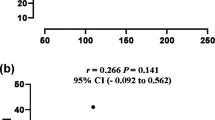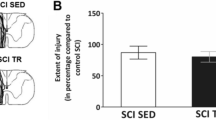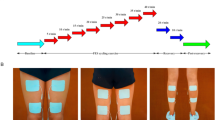Abstract
Introduction:
Although there has been substantial emphasis on the neuromuscular and cardiovascular adaptations following rehabilitation, pulmonary adaptations in individuals with incomplete SCI (iSCI) in response to locomotor training have been less frequently studied. In healthy individuals, effective transition from rest to work is accomplished by a hyperpneic response, which exhibits an exponential curve with three phases. However, the degree to which our current understanding of exercise hyperpnea can be applied to individuals with iSCI is unknown. The purpose of this case series was to characterize exercise hyperpnea during a rest to constant work rate (CWR) transition before and after 12–15 weeks of overground locomotor training (OLT).
Case Presentation:
Six subjects with cervical motor incomplete spinal cord injury participated in 12–15 weeks of OLT. Subjects were trained in 90-min sessions twice a week. All training activities were weight-bearing and under volitional control without the assistance of body-weight support harnesses, robotic devices or electrical stimulation. Six minutes of CWR treadmill walking was performed at self-selected pace with cardiorespiratory analysis throughout the tests before and after OLT. Averaged group data for tidal volume, breathing frequency or VE showed no difference before and after training. VE variability was decreased by 46.7% after OLT.
Discussion:
CWR VE from rest to work was linear throughout the transition. Following OLT, there was a substantial reduction in VE variability. Future research should investigate the lack of a phasic ventilatory response to exercise, as well as potential mechanisms of ventilatory variability and its implications for functional performance.
Similar content being viewed by others
Log in or create a free account to read this content
Gain free access to this article, as well as selected content from this journal and more on nature.com
or
References
Schilero GJ, Spungen AM, Bauman WA, Radulovic M, Lesser M . Pulmonary function and spinal cord injury. Respir Physiol Neurobiol 2009; 166: 129–141.
Linn WS, Adkins RH, Gong H Jr, Waters RL . Pulmonary function in chronic spinal cord injury: a cross-sectional survey of 222 southern California adult outpatients. Arch Phys Med Rehabil 2000; 81: 757–763.
Linn WS, Spungen AM, Gong H Jr, Adkins RH, Bauman WA, Waters RL . Forced vital capacity in two large outpatient populations with chronic spinal cord injury. Spinal Cord 2001; 39: 263–268.
West CR, Bellantoni A, Krassioukov AV . Cardiovascular function in individuals with incomplete spinal cord injury: a systematic review. Top Spinal Cord Inj Rehabil 2013; 19: 267–278.
Olive JL, Dudley GA, McCully KK . Vascular remodeling after spinal cord injury. Med Sci Sports Exerc 2003; 35: 901–907.
Hicks AL, Martin Ginis KA, Pelletier CA, Ditor DS, Foulon B, Wolfe DL . The effects of exercise training on physical capacity, strength, body composition and functional performance among adults with spinal cord injury: a systematic review. Spinal Cord 2011; 49: 1103–1127.
Gorgey AS, Poarch H, Harnish C, Miller JM, Dolbow D, Gater DR . Acute effects of locomotor training on neuromuscular and metabolic profile after incomplete spinal cord injury. NeuroRehabilitation 2011; 29: 79–83.
Baldi JC, Jackson RD, Moraille R, Mysiw WJ . Muscle atrophy is prevented in patients with acute spinal cord injury using functional electrical stimulation. Spinal Cord 1998; 36: 463–469.
Forrest GF, Sisto SA, Barbeau H, Kirshblum SC, Wilen J, Bond Q et al. Neuromotor and musculoskeletal responses to locomotor training for an individual with chronic motor complete AIS-B spinal cord injury. J Spinal Cord Med 2008; 31: 509–521.
Wouda MF, Wejden L, Lundgaard E, Strøm V . Energetic and cardiovascular responses to treadmill walking and stationary cycling in subjects with incomplete spinal cord injury. Spinal Cord 2015; 54: 51–56.
Nash MS, Bilsker S, Marcillo AE, Isaac SM, Botelho LA, Klose KJ et al. Reversal of adaptive left ventricular atrophy following electrically-stimulated exercise training in human tetraplegics. Paraplegia 1991; 29: 590–599.
Wasserman K, Whipp BJ, Casaburi R . Respiratory Control During Exercise. In Comprehensive Physiology. John Wiley & Sons, Inc, 2011, doi:10.1002/cphy.cp030217.
Whipp BJ, Ward SA . Cardiopulmonary coupling during exercise. J Exp Biol 1982; 100: 175–193.
Bergofsky EH . Mechanism for respiratory insufficiency after cervical cord injury; a source of alveolar hypoventilation. Ann Intern Med 1964; 61: 435–447.
Malte CL, Malte H, Wang T . Episodic ventilation lowers the efficiency of pulmonary CO2 excretion. J Appl Physiol 2013; 115: 1506–1518.
Petersson J, Glenny RW . Gas exchange and ventilation-perfusion relationships in the lung. Eur Respir J 2014; 44: 1023–1041.
Harms CA, Wetter TJ, McClaran SR, Pegelow DF, Nickele GA, Nelson WB et al. Effects of respiratory muscle work on cardiac output and its distribution during maximal exercise. J Appl Physiol 1998; 85: 609–618.
Harms CA, Babcock MA, McClaran SR, Pegelow DF, Nickele GA, Nelson WB et al. Respiratory muscle work compromises leg blood flow during maximal exercise. J Appl Physiol 1997; 82: 1573–1583.
Estenne M, De Troyer A . Relationship between respiratory muscle electromyogram and rib cage motion in tetraplegia. Am Rev Respir Dis 1985; 132: 53–59.
De Troyer A, Estenne M, Vincken W . Rib cage motion and muscle use in high tetraplegics. Am Rev Respir Dis 1986; 133: 1115–1119.
Tiftik T, Gökkaya NKO, Malas FÜ, Tunç H, Yalçın S, Ekiz T et al. Does locomotor training improve pulmonary function in patients with spinal cord injury? Spinal Cord 2015; 53: 467–470.
Silva AC, Neder JA, Chiurciu MV, Pasqualin DC, da Silva RC, Fernandez AC et al. Effect of aerobic training on ventilatory muscle endurance of spinal cord injured men. Spinal Cord 1998; 36: 240–245.
Rutchik A, Weissman AR, Almenoff PL, Spungen AM, Bauman WA, Grimm DR . Resistive inspiratory muscle training in subjects with chronic cervical spinal cord injury. Arch Phys Med Rehabil 1998; 79: 293–297.
Wang T-G, Wang Y-H, Tang F-T, Lin K-H, Lien I-N . Resistive inspiratory muscle training in sleep-disordered breathing of traumatic tetraplegia. Arch Phys Med Rehabil 2002; 83: 491–496.
Kirshblum S, Waring W 3rd . Updates for the International Standards for neurological classification of spinal cord injury. Phys Med Rehabil Clin N Am 2014; 25: 505.
Gollie JM, Guccione AA, Panza GS, Jo PY, Herrick JE . Effects of overground locomotor training on walking performance in chronic cervical motor-incomplete spinal cord injury: a pilot study. Arch Phys Med Rehabil 2016: 31292–31298.
Whipp BJ, Ward SA, Lamarra N, Davis JA, Wasserman K . Parameters of ventilatory and gas exchange dynamics during exercise. J Appl Physiol 1982; 52: 1506–1513.
Casaburi R, Barstow TJ, Robinson T, Wasserman K . Influence of work rate on ventilatory and gas exchange kinetics. J Appl Physiol 1989; 67: 547–555.
De Troyer A, Heilporn A . Respiratory mechanics in quadriplegia. The respiratory function of the intercostal muscles. Am Rev Respir Dis 1980; 122: 591–600.
Bodin P, Kreuter M, Bake B, Olsén MF . Breathing patterns during breathing exercises in persons with tetraplegia. Spinal Cord 2003; 41: 290–295.
Monroe MB, Tataranni PA, Pratley R, Manore MM, Skinner JS, Ravussin E . Lower daily energy expenditure as measured by a respiratory chamber in subjects with spinal cord injury compared with control subjects. Am J Clin Nutr 1998; 68: 1223–1227.
Loveridge BM, Dubo HI . Breathing pattern in chronic quadriplegia. Arch Phys Med Rehabil 1990; 71: 495–499.
Johnson BD, Saupe KW, Dempsey JA . Mechanical constraints on exercise hyperpnea in endurance athletes. J Appl Physiol 1992; 73: 874–886.
Estenne M, De Troyer A . Mechanism of the postural dependence of vital capacity in tetraplegic subjects. Am Rev Respir Dis 1987; 135: 367–371.
Eldridge FL . Relationship between phrenic nerve activity and ventilation. Am J Physiol 1971; 221: 535–543.
Forster HV, Haouzi P, Dempsey JA . Control of breathing during exercise. Compr Physiol 2012; 2: 743–777.
Dempsey JA, Harms CA, Ainsworth DM . Respiratory muscle perfusion and energetics during exercise. Med Sci Sports Exerc 1996; 28: 1123–1128.
Sherman MFB, Lam T, Sheel AW . Locomotor-respiratory synchronization after body weight supported treadmill training in incomplete tetraplegia: a case report. Spinal Cord 2009; 47: 896–898.
Le Foll-de Moro D, Tordi N, Lonsdorfer E, Lonsdorfer J . Ventilation efficiency and pulmonary function after a wheelchair interval-training program in subjects with recent spinal cord injury. Arch Phys Med Rehabil 2005; 86: 1582–1586.
Scanlon PD, Loring SH, Pichurko BM, McCool FD, Slutsky AS, Sarkarati M et al. Respiratory mechanics in acute quadriplegia. Lung and chest wall compliance and dimensional changes during respiratory maneuvers. Am Rev Respir Dis 1989; 139: 615–620.
Richardson RS . Oxygen transport: air to muscle cell. Med Sci Sports Exerc 1998; 30: 53–59.
Hart N, Laffont I, de la Sota AP, Lejaille M, Macadou G, Polkey MI et al. Respiratory effects of combined truncal and abdominal support in patients with spinal cord injury. Arch Phys Med Rehabil 2005; 86: 1447–1451.
Baydur A, Adkins RH, Milic-Emili J . Lung mechanics in individuals with spinal cord injury: effects of injury level and posture. J Appl Physiol 2001; 90: 405–411.
Thomaz S, Beraldo P, Mateus S, Horan T, Leal JC . Effects of partial isothermic immersion on the spirometry parameters of tetraplegic patients. Chest 2005; 128: 184–189.
Harms CA . Effect of skeletal muscle demand on cardiovascular function. Med Sci Sports Exerc 2000; 32: 94–99.
Wetter TJ, Harms CA, Nelson WB, Pegelow DF, Dempsey JA . Influence of respiratory muscle work on VO(2) and leg blood flow during submaximal exercise. J Appl Physiol 1999; 87: 643–651.
Chin LMK, Heigenhauser GJF, Paterson DH, Kowalchuk JM . Pulmonary O2 uptake and leg blood flow kinetics during moderate exercise are slowed by hyperventilation-induced hypocapnic alkalosis. J Appl Physiol 2010; 108: 1641–1650.
DePalo VA, Parker AL, Al-Bilbeisi F, McCool FD . Respiratory muscle strength training with nonrespiratory maneuvers. J Appl Physiol 2004; 96: 731–734.
Frankel HL, Coll JR, Charlifue SW, Whiteneck GG, Gardner BP, Jamous MA et al. Long-term survival in spinal cord injury: a fifty year investigation. Spinal Cord 1998; 36: 266–274.
Author information
Authors and Affiliations
Corresponding author
Ethics declarations
Competing interests
The authors declare no conflict of interest.
Rights and permissions
About this article
Cite this article
Panza, G., Guccione, A., Chin, L. et al. Effects of overground locomotor training on the ventilatory response to volitional treadmill walking in individuals with incomplete spinal cord injury: a pilot study. Spinal Cord Ser Cases 3, 17011 (2017). https://doi.org/10.1038/scsandc.2017.11
Received:
Revised:
Accepted:
Published:
DOI: https://doi.org/10.1038/scsandc.2017.11
This article is cited by
-
Locomotor-respiratory coupling in ambulatory adults with incomplete spinal cord injury
Spinal Cord Series and Cases (2022)
-
Effect of repeated locomotor training on ventilatory measures, perceived exertion and walking endurance in persons with motor incomplete spinal cord injury
Spinal Cord Series and Cases (2020)
-
Effect of overground locomotor training on ventilatory kinetics and rate of perceived exertion in persons with cervical motor-incomplete spinal cord injury
Spinal Cord Series and Cases (2019)



